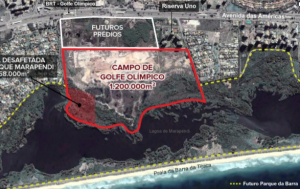“On its way to becoming reality, the project has handily steamrolled all potential roadblocks, from land-use regulations to environmental protection laws to legislative checks-and-balances”.
Em RIO’S OLYMPIC GOLF COURSE WILL TRAMPLE A PROTECTED ECOLOGICAL GEM
Given these protections, the law passed in December 2012 is extreme in its provisions. First, it authorizes the construction of the golf course within the borders of the Marapendi Reserve, using the justification that building a golf course qualifies as sustainable use of the land. Additionally, it redraws the borders of the Marapendi Municipal Reserve in order to completely cut out the section that fell within the intended golf course site. The law effectively nullifies the area’s “permanent protection” status, handing this piece of public land over to a private developer, RJZ
Em THE SOCIAL & ENVIRONMENTAL COSTS OF RIO’S OLYMPIC GOLF COURSE
 |
| Internet |
No último dia 21 divulgamos Artigo: RIO’S OLYMPIC GOLF COURSE WILL TRAMPLE A PROTECTED ECOLOGICAL GEM, de Elena Hodges, ou, ‘Campo de Golfe Olímpico esmagará uma joia ecológica protegida’
Em sequência àquela pesquisa abrangente sobre inúmeros aspectos que envolvem a construção em referência – o Campo de Golfe voltado para os Jogos Olímpicos 2016 – a autora publicou outro texto, desta vez no site Rio on Watch – community reporting on Rio – onde apresenta novos ângulos e consequências daquela decisão – construir um novo campo para a modalidade em questão próximo a dois outros existentes na cidade – e de sua localização sobre uma Área de Proteção Ambiental – APA Marapendi e um Parque Ecológico, que contornam a Lagoa de Marapendi, AMBOS protegidos por legislação ambiental.
O novo artigo pode ser traduzido por ‘Os Custos Sociais e Ambientais do Campo de Golfe Olímpico do Rio de Janeiro’. Se obtivermos a tradução por parte do site republicaremos em seguida.
Mais esclarecimentos do blog no final do post*.
Boa Leitura.
Urbe CaRioca
President of the Organizing Committee for the Rio 2016 Olympic Games, Carlos Nuzman recently remarked that “Rio 2016 is intensifying its relationship with society.” He continued, “The Games will leave a huge legacy for both Rio and Brazil… No other host city will have had such a big transformation from the Games as Rio.”
The social impacts of the 2016 Olympics are indeed intensifying; whether that is a boon to Rio’s residents, however, is, to put it nicely, highly disputed.
The Olympic golf course is the perfect microcosm through which to identify much of what is wrong with the approach to Olympic infrastructure development in Rio. It is emblematic of the ways in which Rio’s preparations for the 2016 Games are deeply problematic.
The site chosen for the golf course sits on 1 million square meters of protected Atlantic Forest on the edge of the Marapendi lagoon in Barra da Tijuca. A mix of fragile mangroves, marshes, and sandbanks, the area contains about 300 identified species, from herons to capybaras to sloths, including endangered species such as the yellow-necked alligator, the beach lizard, and the crested guan.
In order to gain access to the golf course land parcel, Rio’s City Council passed Complementary Law 125 in late December 2012, during an emergency session just before their holiday recess.
The passage of Complementary Law 125 raises grave legal concerns. In order to free up this land for the course, legislative norms and democratic, participatory processes were either undermined or directly violated.
The City government bypassed an array of laws, from the federal Atlantic Forest Lawand Forest Code to municipal laws that designate most of the land as an Area of Environmental Protection (APA), subject to strictsustainable land-use guidelines. The remaining portion of the parcel was part of the public Marapendi Municipal Reserve, an area under “permanent protection,” theoretically off-limits to any and all development.
(…)
____________
Nota do Blog:
No centro do mapa, a área verde claro abaixo da mancha verde escuro pertencia à APA Marapendi e destinava-se ao Parque Municipal Ecológico de Marapendi, trecho do qual 58mil m² já haviam sido doados ao antigo Estado da Guanabara por imposição legal, configurando, portanto, área pública. Em uma faixa situada entre as manchas verde claro e verde escuro deveria ter sido construída a Avenida Prefeito Dulcídio Cardoso, limite entre a APA e o Parque, uma obrigação dos construtores dos edifícios no trecho onde era permitido, próximo da Avenida das Américas. A obrigação foi dispensada; a Via Projetada foi eliminada e também incorporada ao Campo de Golfe, tal como a área antes protegida, proteção esta cancelada pelo atual Prefeito, hoje presidente do C40, e pelos Vereadores da Cidade do Rio de Janeiro. O trecho restante entra a Avenida e a margem da Lagoa de Marapendi seria também doada e incorporada ao Parque Ecológico. A obrigação foi dispensada.
A outra mancha verde indicada à direita do terreno do Campo de Golfe foi doada à APA como compensação pela transferência de gabaritos de altura para o trecho junto da Avenida das Américas. No caso do Golfe a transferência também foi feita, porém, a propriedade continuou privada e o zoneamento ambiental foi modificado para permitir a construção do campo. A cidade e os moradores perderam parte da APA e do Parque Ecológico. Os investidores ficaram com todas as vantagens sob o argumento da Prefeitura – enganoso – de que o campo será público e foi compensado pela criação do parque (futuro) na Praia da Reserva, área já pertencente à APA.
Nota do Blog:
No centro do mapa, a área verde claro abaixo da mancha verde escuro pertencia à APA Marapendi e destinava-se ao Parque Municipal Ecológico de Marapendi, trecho do qual 58mil m² já haviam sido doados ao antigo Estado da Guanabara por imposição legal, configurando, portanto, área pública. Em uma faixa situada entre as manchas verde claro e verde escuro deveria ter sido construída a Avenida Prefeito Dulcídio Cardoso, limite entre a APA e o Parque, uma obrigação dos construtores dos edifícios no trecho onde era permitido, próximo da Avenida das Américas. A obrigação foi dispensada; a Via Projetada foi eliminada e também incorporada ao Campo de Golfe, tal como a área antes protegida, proteção esta cancelada pelo atual Prefeito, hoje presidente do C40, e pelos Vereadores da Cidade do Rio de Janeiro. O trecho restante entra a Avenida e a margem da Lagoa de Marapendi seria também doada e incorporada ao Parque Ecológico. A obrigação foi dispensada.
A outra mancha verde indicada à direita do terreno do Campo de Golfe foi doada à APA como compensação pela transferência de gabaritos de altura para o trecho junto da Avenida das Américas. No caso do Golfe a transferência também foi feita, porém, a propriedade continuou privada e o zoneamento ambiental foi modificado para permitir a construção do campo. A cidade e os moradores perderam parte da APA e do Parque Ecológico. Os investidores ficaram com todas as vantagens sob o argumento da Prefeitura – enganoso – de que o campo será público e foi compensado pela criação do parque (futuro) na Praia da Reserva, área já pertencente à APA.




